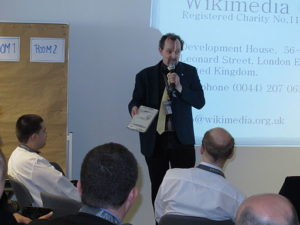
Image attribution: By Manuel Schneider (Own work) [GFDL (http://www.gnu.org/copyleft/fdl.html) or CC BY-SA 3.0 (http://creativecommons.org/licenses/by-sa/3.0)], via Wikimedia Commons
Image content: Wikimania Conference 2012 cluboffice Berlin; session “state of the chapters part III”
Roger Bamkin presenting Wikimedia UK; captioned as follows:
“while I prepared my presentation on my laptop it broke, so I prepared my presentation on my laptop” (used a felt tip to take notes on the white cover of the computer)
Example team process: “Wearing my lion slippers, I leapt about onstage. . . .”
An App produced by Kate Arkless Gray a.k.a. SpaceKate, won the Most Inspiring App category of the 2013 NASA International Space Apps Challenge.
Gray, a journalist, wrote about the experience, starting with chance meetings and a little advance investigation and preparation. Reading her account shows that it might be a good strategy to come prepared, and to contact potential team members in advance.
Back in London, I signed up for the Space Apps Challenge, and then it dawned on me. I would need someone like João to make my idea into reality. I emailed and said that if he wanted to come and work on a cool project, I would give him a place to stay.
NASA’s Chris Gerty would be at the London event I discovered. What a treat, I’d met him before while chasing rockets and doing stories on NASA. In fact, it was down to burritos that we had met. I chatted to him in the queue at Firebirds burritos in Houston because he had a NASA sticker on his laptop.
As the event began, people gathered in teams around the suggested projects. I sent out a tweet to see if anyone fancied joining João and I on our quest to get an app to space. That’s when Ketan Majmudar got in touch. We’d met at the BBC some time ago when we went to see Bill Thompson’s radio show BBC Click being recorded. Small world.
We got down to work, with João looking at the data, and Ket planning the app and me scribbling notes on post-its and temporary whiteboard sheets. It was real. We were doing it. What’s more, we were all excited.
Creating T-10
As the guys got on with some technical wrangling, I dashed around, excited. It was around this point that Dario Lofish arrived. I overheard him saying to one of the organisers that he’d just got there. “Join our team!” I said, excitedly, before speedily talking him through several ideas at once. He came over and said hello, then we said he should take a look around in case something else took his fancy, rather than just succumb to my ambush like that. I secretly hoped that he would come back to us though. As a designer he would bring an extra skillset to our team, and anyway, it’s always nice to have someone else to talk to when the others were doing the hard coding.
We talked through the app structure, designed the rough layout of the screens and reported back to Ket and João. Things were really coming together. It was super exciting.
We had dinner, we had a beer, and then we found out that what we had thought was the deadline to present our work was actually the deadline for us to leave the space. Uh-oh. It would be a late night.
Presentation notes
João and I got the nightbus home and Dario heroically promised that we’d have a presentation ready for the next day. Arriving the next morning we were all tired, but hyped. Dario’s slides were amazing, Ket and João had created a prototype of the app. Suddenly my mad idea was a real programme on an iPad. I was set to present to the group. I really didn’t want to let the guys down. Their incredible work on T-10 deserved to be recognised. I was shaking slightly, it was down to me to convince everyone else that our app deserved to win.
Wearing my lion slippers, I leapt about onstage. . . .
Read the whole story at this website. Be sure to click the link to see the description of the T-10 App, itself, which incorporates the ISSWave app update which solved a 2013 SpaceAppChallenge of “Spot the Station,” whereby waves by humans to the orbiting International Space Station were organized using Twitter. See the 2013 expansion plan for the app here, and a description of the operation of the app as designed in 2010 here.
Visit the next page to read about the winning apps from the 2014 SpaceAppsChallenge.



